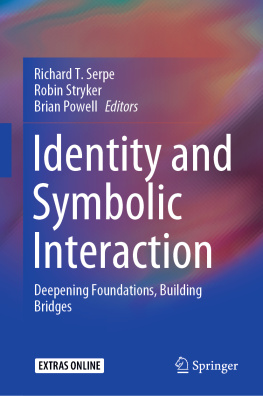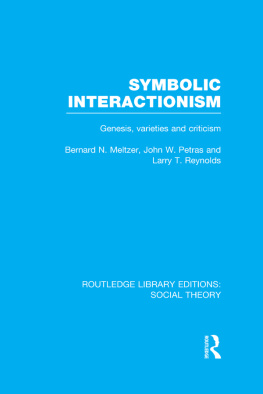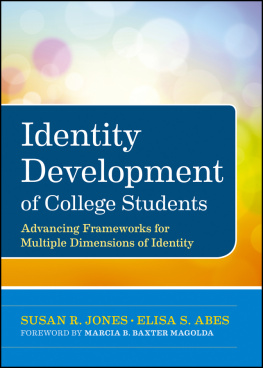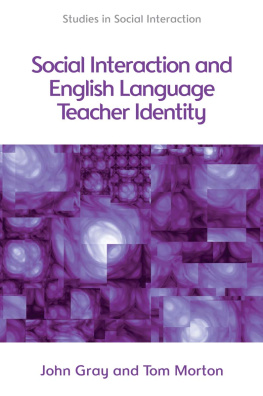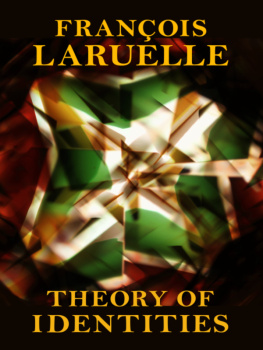Editors
Richard T. Serpe
Department of Sociology, Kent State University, Kent, OH, USA
Robin Stryker
Department of Sociology, Purdue University, West Lafayette, IN, USA
Brian Powell
Department of Sociology, Indiana University Bloomington, Bloomington, IN, USA
ISBN 978-3-030-41230-2 e-ISBN 978-3-030-41231-9
https://doi.org/10.1007/978-3-030-41231-9
Springer Nature Switzerland AG 2020
This work is subject to copyright. All rights are solely and exclusively licensed by the Publisher, whether the whole or part of the material is concerned, specifically the rights of translation, reprinting, reuse of illustrations, recitation, broadcasting, reproduction on microfilms or in any other physical way, and transmission or information storage and retrieval, electronic adaptation, computer software, or by similar or dissimilar methodology now known or hereafter developed.
The use of general descriptive names, registered names, trademarks, service marks, etc. in this publication does not imply, even in the absence of a specific statement, that such names are exempt from the relevant protective laws and regulations and therefore free for general use.
The publisher, the authors and the editors are safe to assume that the advice and information in this book are believed to be true and accurate at the date of publication. Neither the publisher nor the authors or the editors give a warranty, expressed or implied, with respect to the material contained herein or for any errors or omissions that may have been made. The publisher remains neutral with regard to jurisdictional claims in published maps and institutional affiliations.
This Springer imprint is published by the registered company Springer Nature Switzerland AG
The registered company address is: Gewerbestrasse 11, 6330 Cham, Switzerland
Preface
This book represents a labor of scholarship but also of love. The three of us who co-edited this book have never collaborated on a scholarly project until now, but we have known each other since the mid-1980s. At that time, Brian came to Indiana University as a postdoctoral fellow in a measurement program funded by the National Institutes of Mental Health. Richard was completing graduate school at Indiana University with Sheldon Stryker as his Ph.D. advisor, and Robin, Shels daughter, was living in Bloomington completing her University of Wisconsin Ph.D. in sociology. Robin and Richard shared an office belonging to Shel in the Institute of Social Research, later named in honor of Karl Schuessler, who, along with Shel, made Indiana University one of the top departments of sociology in the world. The twoRobin and Richard that isbonded for life in an epic fight against wasps who nested in our office window. Meanwhile, Brian was just across the street in Memorial Hall, happily missing out on this particular battle.
Over the next thirty years, while Richard collaborated with Shel to further develop the structural symbolic interactionism and identity theory that Shel had pioneered, Brian developed himself as a scholar of family, education, gender, and sexuality, and Robin developed herself as a macro-sociological scholar of law and society, inequality, and the state. For 25 years now, Robin also has been teaching Mead and the symbolic interaction paradigm to graduate students in her courses on sociological theory. While Brian took a job at Indiana University and remained there alongside Shel, Richard and Robin were employed elsewhere. The three of us remained in touch and saw each other often, perpetually networked through our respective relationships with Shel.
It is fitting then that the three of us come together to co-edit this book. In this, our first scholarly collaboration, we hope to honor Shel in a way that he would have appreciated. Consistent with Shels orientations, we sought to produce a book that, while mindful of the road already trod by symbolic interactionism and identity theory, would build on that road to provide new theoretical insights and methodological advances.
As well, and consistent with Shels (2008) own reflections on the development and content of structural symbolic interactionism and identity theory, and his priorities for future development, we wanted to emphasize the applicability of identity theory across a wide range of sociological topics. We wanted to show how identity theory and research offer sociological understanding and explanation linking micro to macro and consequently (re)connecting social psychology and macro-sociology. As well, while deepening understanding and explanation within the traditional bailiwick of Indiana School structural symbolic interaction and identity theory, we wanted to forge new bridges to other theoretical paradigms and research programs in the social sciences. We hope that this book we produced with the help of a great many colleagues in sociology and beyond lives up to our aspirations.
Although the three of us first encountered Shel in different role relationshipsteacherstudent for Richard, fatherdaughter for Robin, and senior colleaguejunior colleague for Brianall of us benefited from Shels mentorship and feedback with respect to research, teaching, and administration within the scholarly academy. Though we did not always agree with him, the reflected appraisals we attached to our interactions with Shel have had a profound influence on the development and enactment of our professional identities. Although today Shel is no longer with us in the world of the living, we all have internalized Shels that contribute to internal conversations between I and Me to shape our behavior. It is no accident that, for all of us, as it was for Shel, graduate education and mentorship is a top priority, as is leaving a scholarly legacy upon which others canand will want tobuild.
Shel often said that we should consider every idea others shared because learning from others is the foundation of the academy. He was also clear that one does not need to agree with the argument, but before one can critique others ideas, one needs both to understand and respect their position. You could always find Shel in the front row of any talk or presentation he attended. He was happiest when engaged in the process of exchanging ideas. Thus, honoring Shel after his passing meant looking forward to the enterprise of building and exchanging new ideas and scholarship about identity theory and symbolic interactionism.
One way we did so was by organizing a gathering of scholars and colleagues whose work extends or bridges from the ideas Shel spent over 50 years theorizing, researching and writing about. The Indiana University Identity Conference, which took place on April 13 and 14, 2018, brought together established scholars to present new empirical or theoretical papers. Many of the papers presented at the conference are in this book. We thank all of the scholars who participated in this conference, either by presenting their work or by contributing to an appreciative, but constructively critical audience. We especially want to thank those who contributed their best and cutting edge papers written for the conference, and those who, while not in attendance, signed on to write a chapter for this volume. We also wish to acknowledge and thank Springer for agreeing to publish and disseminate this book. Lastly, we want to thank Indiana University for hosting and providing support for the conference.

